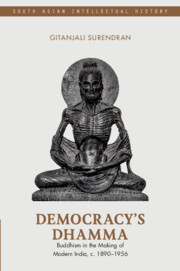Book contents
- Frontmatter
- Dedication
- Contents
- List of Figures
- Acknowledgements
- List of Abbreviations
- Introduction: Buddhism in the Making of Modern India
- 1 Anagarika Dharmapala in India
- 2 Dharmapala and Vivekananda in an Age of Universalism
- 3 Buddhism and The Bhadralok
- 4 The Buddhist Bay: Buddhist Mobility Across the Bay of Bengal
- 5 Buddhist Relics, The Mahabodhi Temple and The Discourse of a Shared Buddhism
- 6 Buddhism as a Civil Religion and Hindutva
- 7 Buddhism, Anti-Caste Radicalism and Socialism
- 8 Ambedkar, Dhamma and Democracy
- Conclusion: The Destinies of Buddhism
- Bibliography
- Index
5 - Buddhist Relics, The Mahabodhi Temple and The Discourse of a Shared Buddhism
Published online by Cambridge University Press: 28 November 2024
- Frontmatter
- Dedication
- Contents
- List of Figures
- Acknowledgements
- List of Abbreviations
- Introduction: Buddhism in the Making of Modern India
- 1 Anagarika Dharmapala in India
- 2 Dharmapala and Vivekananda in an Age of Universalism
- 3 Buddhism and The Bhadralok
- 4 The Buddhist Bay: Buddhist Mobility Across the Bay of Bengal
- 5 Buddhist Relics, The Mahabodhi Temple and The Discourse of a Shared Buddhism
- 6 Buddhism as a Civil Religion and Hindutva
- 7 Buddhism, Anti-Caste Radicalism and Socialism
- 8 Ambedkar, Dhamma and Democracy
- Conclusion: The Destinies of Buddhism
- Bibliography
- Index
Summary
BUDDHIST OBJECTS AND THE DISCOURSE OF SHARED BUDDHISM
The story of modern Buddhism in India is peppered with histories, descriptions and itineraries of objects. These were often being unearthed anew, both in archaeological digs around the Indian subcontinent and in the public imagination. Objects, images, artefacts et al. could take on an entirely new meaning in this period. Through the exploration of the 20th-century cult of Buddhist relics, not only can we see new processes of meaning-making at various sites from academia to the public sphere but also attempts at public pedagogy, collective identity formation and a nostalgia for a lost past glory.
We have already noted 19th-century British archaeology's obsession with Buddhist sites and objects. Tapati Guha-Thakurta with her usual perceptiveness argues that the ASI was established in part to unearth Buddhist sites in India. As British archaeology developed in India, Buddhist antiquities and relics provoked a great deal of interest among the British heads of archaeological expeditions. Many of these often larger-than-life figures like Alexander Cunningham were embroiled in controversies around what resembled looting raids of antiquities and relics from India, and British officials acknowledged as much by the early 20th century. Eventually, this indiscriminate looting was replaced by organized excavation of sites and collection of artefacts for channelling into museums. Saloni Mathur points out that the legacy of this chaotic early phase of unofficial acquisition and plunder in the Indian colony continues to haunt the colonial-era museums in which many of these objects ended up. Debates over archaeology and history were central to Buddhist community and identity formation.
Museums set up in the three capitals of Bombay, Madras and Bengal Presidencies were full of Buddhist material, which often occupied a special pride of place. We have already discussed the Indian Museum's Barhut stupa exhibit in Calcutta which was a prize for the British among treasured Buddhist remains combining artistry, craftsmanship and archaeological practice. By the early 20th century, Indian urban publics became increasingly absorbed with the fate of Buddhist objects, particularly relics. Archaeologists, museologists and officials had begun to make a distinction between parts of Buddhist material remains that were artistically valuable and therefore to remain in colonial custody, and the parts with spiritual or religious value but no aesthetic value.
- Type
- Chapter
- Information
- Democracy's DhammaBuddhism in the Making of Modern India, c. 1890–1956, pp. 163 - 207Publisher: Cambridge University PressPrint publication year: 2025

